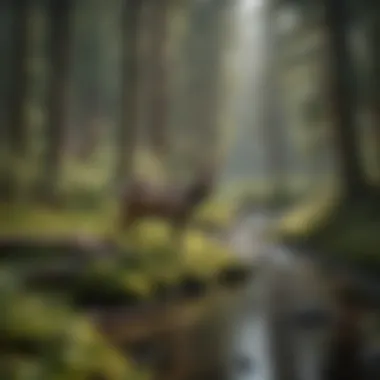Understanding the Importance of the Washington Wilderness Pass


Intro
The Washington Wilderness Pass plays a vital role in fostering sustainable forestry and responsible outdoor recreation in Washington state. This pass is not merely a ticket for the trails; it is a commitment to conservation. It allows outdoor enthusiasts to explore the breathtaking wilderness while participating in the necessary funding for maintenance and protection of these cherished natural areas.
Overview of Forestry Practices
Forestry involves the science of managing forests and woodlands. Its practices impact both ecosystem balance and human utilization of resources. This holistic approach ensures that forests thrive while providing for societal needs.
Definition of Forestry
Forestry encompasses a range of activities aimed at managing forested areas. This includes logging, conservation, and the restoration of natural habitats. Each action taken within forestry has implications for biodiversity, climate regulation, and soil health.
Importance of Forestry in Ecosystem Management
Forestry is integral to sustaining ecosystems. Forests serve as carbon sinks, helping mitigate climate change. They also provide habitats for wildlife and protect watersheds. Effective forestry practices can enhance resilience against natural disturbances, offering a multitude of ecological benefits.
Sustainable Forest Management
Sustainable forest management is the practice of managing forests to maintain their biodiversity, productivity, and regeneration capacity over time. The focus is on balancing environmental health with economic interests.
Principles of Sustainable Practices
- Ecosystem Health: Protect the ecological integrity of forest systems.
- Community Engagement: Involve local communities in forestry decisions.
- Adaptive Management: Adjust practices based on monitoring and research.
- Economic Viability: Ensure that forestry practices are financially sustainable.
Techniques in Sustainable Management
Sustainable forestry techniques include selective logging, reforestation, and controlled burns. Each method aims to minimize environmental impact while ensuring the forest remains productive and healthy.
Woodland Stewardship Strategies
Woodland stewardship is about taking responsible actions towards maintaining healthy forest ecosystems. It recognizes that the land is a shared resource deserving of careful management and protection.
Importance of Woodland Stewardship
Effective stewardship enhances forest health and ensures productive landscapes for future generations. This also promotes resilience against threats such as pests, diseases, and climate change.
Best Practices for Landowners
Landowners can adopt various best practices for effective woodland stewardship:
- Regular Monitoring: Keep an eye on forest health and ecological changes.
- Wildlife Conservation: Promote habitats for native species.
- Community Involvement: Engage neighbors and local groups in stewardship efforts.
- Educational Outreach: Share knowledge about sustainable practices and engage local schools and community organizations.
In summary, the Washington Wilderness Pass is not just a means for access but an investment in sustainable forestry and land stewardship. By understanding the connections between responsible recreation and forestry, we can better appreciate the importance of this initiative.
Prologue to the Washington Wilderness Pass
The Washington Wilderness Pass is critical for outdoor enthusiasts and conservation advocates alike. It functions not just as a ticket but as a commitment to preserving the natural beauty of Washington state while promoting responsible outdoor activities. For anyone looking to explore the various trails and wilderness areas, understanding this pass is paramount. In this section, we explore the definition, purpose, and historical context of the Washington Wilderness Pass, revealing its significance and impact on both outdoor recreation and environmental stewardship.
Definition and Purpose
The Washington Wilderness Pass is a permit that grants users access to specific trails and recreational sites in Washington's wilderness. Its primary purpose is to facilitate access while supporting various conservation efforts. Users pay a fee when they obtain the pass, which goes directly towards trail maintenance, habitat preservation, and overall ecological health of the region. This helps alleviate some of the financial burdens on state and federal agencies tasked with caring for these lands.
Additionally, the pass promotes accountability among users. It encourages outdoor lovers to respect the natural environment while enjoying the beauty of the region. Without such initiatives, public lands would face increased wear and tear, leading to potential degradation and loss of biodiversity.


Historical Context
The inception of the Washington Wilderness Pass can be traced back to efforts aimed at reconciling the growing demand for outdoor recreation with the necessity of conserving natural environments. As the popularity of hiking and camping surged in the late 20th century, so did the challenges associated with maintaining trails and protecting wildlife habitats.
Initial attempts to manage this situation included introducing limited access fees and encouraging responsible visitation practices. Over time, these measures evolved into more structured programs, culminating in the establishment of the Washington Wilderness Pass.
Its development parallels broader environmental movements, which increasingly aim to involve the public in conservation efforts. The pass not only reflects changes in outdoor recreation trends but also the growing recognition of the need to protect precious natural resources.
In summary, the Washington Wilderness Pass is more than just a pass; it symbolizes a collective responsibility to both enjoy and safeguard Washington’s wilderness areas for future generations.
This introduction sets the stage for a deeper examination of the requirements, benefits, and implications this pass entails for both users and the environment.
Navigating the Washington Wilderness Pass Requirements
Understanding the requirements for the Washington Wilderness Pass is crucial for outdoor enthusiasts, conservationists, and stakeholders alike. This section provides insight into the specific eligibility criteria necessary to obtain the pass, as well as where it can be acquired. Knowing these elements is vital for ensuring that individuals can enjoy the wilderness while contributing positively to its maintenance and management.
Eligibility Criteria
To acquire a Washington Wilderness Pass, certain eligibility criteria must be met. Primarily, this pass is intended for those who intend to engage in recreational activities within designated wilderness areas. Here are some key aspects of the eligibility criteria:
- Age Requirements: The pass is generally available for individuals aged 16 and above. Children under this age can access most areas without a pass, making outdoor experiences accessible for families.
- Type of Recreation: The pass is often required for activities such as hiking, camping, or fishing within wilderness zones. Certain areas might have additional rules, so it is always good to check local guidelines prior to planning an outing.
- Purpose of Use: Consumers must use the pass for personal recreational purposes. Commercial activities often necessitate different permits, which are not covered by the Wilderness Pass.
These criteria help balance access to the wilderness while ensuring that management authorities can apply necessary regulations to maintain ecological integrity.
Where to Obtain the Pass
Acquiring a Washington Wilderness Pass is a straightforward process, designed to enhance accessibility for outdoor activities. Here are the recommended steps to secure one:
- Online Purchase: The most convenient method is through the Washington State Parks website. This portal allows users to obtain the pass efficiently. The online system is user-friendly and offers clear instructions for payment and application requirements.
- In-Person Options: Passes can also be purchased at designated parks and recreation offices across Washington. Visitor centers often stock these passes, and staff can provide additional information about the specific wilderness areas they cover.
- Local Retailers: Certain outdoor equipment stores may offer the pass as well. These locations are good for enthusiasts who prefer in-person transactions and would like expert advice on hiking trails or camping gear at the same time.
In summary, understanding the eligibility criteria and where to obtain the Washington Wilderness Pass will ensure a smoother experience for those looking to explore the vast natural beauty of the region. By adhering to these requirements, users contribute to the sustainability of these treasured spaces for future generations.
Benefits of Having a Washington Wilderness Pass
The Washington Wilderness Pass is a key resource for both individuals and communities engaged in outdoor recreation. This pass significantly enhances the experience of exploring Washington's natural beauty while contributing to conservation and infrastructure.
Access to Exclusive Areas
One of the foremost advantages of acquiring a Washington Wilderness Pass is the ability to access exclusive areas that may be limited to pass holders. Numerous trails and lush landscapes within state parks and national forests cater specifically to those who possess this pass.
These areas often offer less crowded environments, which is essential for anyone seeking an authentic outdoor experience. For hikers, campers, and nature enthusiasts, these secluded trails lead to spectacular vistas, unique wildlife encounters, and a sense of tranquility away from urban life. The pass provides direct support for the maintenance of these sites, ensuring their preservation for future use.
Moreover, the restricted access serves to alleviate pressure on overused areas, allowing for a more sustainable approach to recreation. It creates a balance between enjoyment and conservation, making it beneficial for the environment and visitors alike.
Support for Conservation Efforts
The purchase of a Washington Wilderness Pass directly contributes to statewide conservation initiatives. A portion of the funds collected is allocated to various conservation projects, which are crucial for preserving the natural integrity of Washington's diverse ecosystems.
These efforts may include:
- Restoration of damaged habitats: Areas impacted by human activity need active rehabilitation to maintain biodiversity.
- Wildlife protection programs: Ensuring that endangered species find safe havens is paramount for ecological balance.
- Educational outreach: Programs aimed at educating the public on the importance of conservation help foster a deeper respect for nature.
This financial support helps to manage invasives species and enhances biodiversity, which benefits outdoor enthusiasts by minimizing the adverse impacts on their recreational experience. By investing in the pass, users are essentially investing in the very resources necessary for enjoyable outdoor activities.
Improvement of Facilities and Maintenance


Facilities and amenities within wilderness areas often require ongoing maintenance. The Washington Wilderness Pass funds maintenance efforts that improve these facilities in several critical ways.
Investments made from the pass can improve:
- Trail development and upkeep: Well-maintained trails reduce the chances of accidents and enhance accessibility.
- Campsite management: Proper campsite facilities can provide visitors with resources such as restrooms and water sources that improve the overall outdoor experience.
- Signage and information boards: Clear instructions and informative signage help guide visitors, promoting safe and responsible uses of the wilderness.
Impact on Outdoor Recreation
The Washington Wilderness Pass is more than just a mere access ticket to the state's magnificent natural landscapes; it serves as a cornerstone for fostering sustainable outdoor recreation. The benefits of this pass extend beyond individual enjoyment, affecting communities, economies, and conservation efforts alike. As we examine its impact, two key elements emerge: promoting responsible enjoyment of nature and encouraging local economies.
Promoting Responsible Enjoyment of Nature
One of the primary functions of the Washington Wilderness Pass is to promote a sense of accountability among outdoor enthusiasts. By requiring a pass for access, it establishes a system where users directly contribute to the maintenance and preservation of natural spaces. This creates a culture of responsibility, where hikers, campers, and other visitors are reminded that their activities can have lasting effects on the environment.
Visitors are encouraged to engage in practices that minimize their ecological footprint. For instance, they learn to adhere to Leave No Trace principles, which protect wildlife and plant life. This emphasis on responsible recreation ensures that natural landscapes remain untouched and serene.
Moreover, proceeds from the pass aid in funding conservation projects. This direct connection between pass sales and preservation efforts cultivates a sense of stewardship among users.
"The health of our wilderness areas depends on the actions of those who enjoy them. The Washington Wilderness Pass is a vital link between users and preservation."
Encouraging Local Economies
The Washington Wilderness Pass also plays a significant role in bolstering local economies. By promoting outdoor activities, such as hiking and camping, it attracts a steady flow of visitors to popular locations. People often seek local accommodations, food, and gear shops, which leads to direct economic input into communities.
Many towns near popular wilderness areas benefit from increased tourism. The presence of outdoor enthusiasts creates opportunities for local businesses, from restaurants to outdoor recreation retail shops. This injection of capital can be essential for small towns that rely on seasonal tourism for their livelihood.
In addition, events centered around outdoor recreation often draw crowds. Guided tours, workshops, and festivals related to nature and outdoor lifestyles can flourish when a significant number of visitors frequent these areas. These activities provide a platform for local artisans and service providers to showcase their offerings.
In summary, the Washington Wilderness Pass not only enhances the outdoor recreation experience but also facilitates a responsible, sustainable approach to enjoying nature and fosters economic growth in surrounding communities. This dual focus on accountability and economic vitality ultimately strengthens both the recreational and natural landscapes in Washington.
Wilderness Pass and Sustainable Land Management
The Washington Wilderness Pass functions not just as a tool for access to natural spaces but also plays a vital role in sustainable land management. It serves as a mechanism that facilitates a balance between human enjoyment and the conservation of the state's diverse ecosystems. The implications of this pass extend beyond recreational access; it provides a structured approach to managing public lands while promoting responsible usage.
One of the core benefits of the Wilderness Pass is that it helps to mitigate the negative impacts of human activity on the environment. By regulating the number of visitors to certain areas, it contributes to the maintenance of fragile ecosystems. Overcrowding can lead to resource depletion, soil erosion, and habitat destruction. When visitors are limited, it allows natural processes to continue and supports the regeneration of wildlife habitats.
Moreover, the revenue generated from the pass is typically reinvested into the very landscapes that are being accessed. This funding goes toward trail maintenance, sanitation facilities, and educational programs about environmental stewardship. Therefore, those who purchase a pass are not only gaining access but also contributing to the sustainability of these cherished environments.
Organizations involved in land management are increasingly viewing the Wilderness Pass as a pivotal element in their conservation strategy. By implementing this system, they can gather data on visitor patterns and assess environmental impact more effectively. This data-driven approach allows for adaptive management practices, ensuring that natural resources are utilized in ways that are both efficient and sustainable.
Balancing Human Activity with Conservation
Balancing human activity with conservation is a significant concern for land managers and outdoor enthusiasts alike. The Wilderness Pass promotes this balance by establishing guidelines that encourage responsible engagement with nature. For instance, certain areas can experience closures or restrictions at different times of the year, allowing habitats to recover from human activity.
Additionally, guidelines associated with the Wilderness Pass encourage behaviors that minimize negative environmental impacts. Pass holders are often provided with best practices related to Leave No Trace principles. These principles emphasize the importance of reducing one’s footprint while enjoying outdoor spaces, promoting a culture of respect toward nature.
The dialogue around this balance has evolved. Many users recognize that their presence in natural spaces has consequences. The Wilderness Pass cultivates a sense of stewardship, urging visitors to appreciate the areas they explore and leaving them intact for future generations. This cultural shift is essential for ensuring that outdoor recreation can coexist with conservation efforts efficiently.
Engaging Stakeholders in Conservation Practices
Engaging stakeholders in conservation practices is crucial for the effectiveness of the Wilderness Pass. Stakeholders encompass a range of groups including local communities, environmental organizations, government agencies, and the outdoor recreation industry. Each group contributes unique perspectives and resources that enhance conservation outcomes.
Collaborative efforts foster a shared responsibility toward the management of natural resources. Stakeholder engagement can lead to grassroots initiatives aimed at promoting sustainability. For example, local volunteers may organize clean-up events or educational workshops that empower community members to become active participants in conservation efforts.


Furthermore, communication between stakeholders often results in the establishment of better practices. Input from those using the wilderness can highlight specific concerns or highlight successful strategies in conservation. This feedback loop informs policymakers and land managers about the real-world implications of wilderness management decisions.
Challenges and Considerations
The Washington Wilderness Pass presents several challenges and considerations that merit careful examination. Understanding these factors is integral for ensuring that the pass serves its intended purpose while addressing the needs of users and the conservation of the natural environment. Economic barriers and the impact of increased traffic on natural resources emerge as two significant areas of concern that need attention.
Economic Barriers for Users
Access to the Washington Wilderness Pass can be influenced by economic factors, creating barriers for certain user groups. The cost of securing a pass, while necessary for supporting conservation efforts, can deter individuals who are financially constrained. This reality raises questions about equity in outdoor recreation access. Approaches may need to be considered to make the pass more affordable for low-income families or individuals.
Moreover, outdoor spaces are essential for mental and physical well-being. If financial constraints prevent a segment of the population from accessing these areas, it risks perpetuating inequalities. Solutions such as subsidized passes or income-based pricing could be explored. Collaborative efforts with non-profits or local governments might also provide support for those unable to bear the cost of the pass.
Impact of Increased Traffic on Natural Resources
The increasing popularity of the Washington Wilderness Pass has led to heightened visitor presence in natural areas. This fluctuation in traffic raises concerns about the sustainability of these ecosystems. Overcrowding can lead to soil erosion, wildlife disturbances, and degradation of vegetation. Sustaining the integrity of these areas is essential for the long-term health of the ecosystem.
Management practices will need to evolve as traffic patterns change. This could involve monitoring visitor numbers and implementing measures such as timed entry systems or limits on group sizes. Restoration efforts may also be required in particularly impacted areas to rehabilitate ecosystems that have suffered from heavy use.
To facilitate positive outcomes, collaboration with stakeholders—including local communities, environmental groups, and government agencies—will be crucial. Effective communication about responsible use of natural resources must be emphasized. Thus, the pass not only enables access but also fosters a shared responsibility towards preserving the wilderness.
"Sustainable management must balance access with the need to protect the rich biodiversity of Washington’s wilderness areas."
In summary, while the Washington Wilderness Pass opens the door for many into the great outdoors, it also brings challenges that authorities and users must confront. Successfully navigating these challenges will require ongoing dialogue, policy adjustments, and a commitment to conservation.
Future of the Washington Wilderness Pass
The Washington Wilderness Pass plays a significant role in shaping the future of outdoor recreation and conservation in Washington state. As the demand for access to outdoor spaces continues to rise, the framework around the Wilderness Pass must adapt and evolve. Looking forward, there are key factors that will determine the effectiveness and sustainability of the pass, notably in policy changes and environmental adaptability.
Potential Policy Changes
Policy changes are crucial for maintaining the relevance of the Washington Wilderness Pass. Changes can originate from both state-level initiatives and grassroots movements advocating for enhanced wilderness management. These changes often focus on three core aspects:
- Funding Mechanisms: As operational costs grow, there is a pressing need to reassess funding structures. Future policies might explore increased fees or alternative funding sources, ensuring that financial support aligns with preserving natural resources.
- Access Regulations: Heightened interest in outdoor spaces could lead to revised access policies. Striking a balance between visitor numbers and ecological integrity will be essential. Controlled access measures, such as timed reservations, might be implemented in pristine areas to prevent overuse.
- Community Involvement: Engaging local communities in policymaking can foster a sense of ownership and responsibility toward wilderness areas. Collaborative policies could lead to more effective stewardship and greater public support.
Adapting to Environmental Changes
The Washington wilderness is not immune to the effects of climate change and other environmental pressures. Adapting the Wilderness Pass to these changing conditions is imperative. Key considerations include:
- Ecological Monitoring: Continuous assessment of ecological health is vital. Future iterations of the pass could integrate participatory monitoring programs that involve users in tracking environmental changes, thus fostering a collective responsibility among outdoor enthusiasts.
- Resilience Planning: Policies must incorporate strategies that boost the resilience of ecosystems against climate impacts. This might involve redesigning trails to prevent erosion or implementing sustainable forestry practices to support biodiversity.
- Educational Components: Environmentally-focused educational programs can be included as part of the Wilderness Pass framework, informing users about sustainable practices, and enhancing their experience while minimizing harm to the environment.
"The Washington Wilderness Pass is more than a ticket to enter; it represents a commitment to preserving our natural heritage for future generations."
Culmination
The Washington Wilderness Pass represents more than just a ticket to access the vast wilderness areas of Washington state. It is a cornerstone for sustainable use of natural resources and fostering responsible outdoor activities. This conclusion synthesizes key elements discussed in this article, emphasizing the multilayered benefits of the pass, the significant considerations surrounding its implementation, and its strategic role in conservation efforts.
Summary of Key Points
In summary, the Washington Wilderness Pass serves critical functions:
- Access to Nature: It opens the doors to numerous pristine areas, ensuring that outdoor enthusiasts can safely explore and enjoy the natural beauty of Washington.
- Funding for Conservation: Revenue generated from the pass directly supports conservation efforts, helping maintain trails and facilities that are vital for both wildlife and human recreation.
- Community Engagement: The pass encourages local involvement and stewardship of natural resources, promoting a sense of shared responsibility among users.
- Sustainable Recreation: It is pivotal in managing human impact on the environment, balancing access with the need for preservation of ecosystems.
Overall, the pass not only provides tangible benefits for recreational users but also enhances the overall health of the state's natural landscapes through structured management.
Final Thoughts on Conservation and Recreation
As outdoor recreation continues to grow, the importance of the Washington Wilderness Pass cannot be overstated. Its role in promoting sustainable forestry and conservation practices positions it as a vital tool for future generations. The challenges of climate change and increasing recreational demand put added pressure on Washington's natural resources. Therefore, sustainable access through the wilderness pass must be prioritized.
It is essential for users to understand their part in this ecosystem. By purchasing and utilizing the Washington Wilderness Pass, individuals contribute to the upkeep and preservation of precious landscapes. Ultimately, the balance between enjoying nature and protecting it will shape the wilderness experience for years to come.
The Washington Wilderness Pass reflects a commitment to both recreation and conservation, ensuring that wild spaces remain available for everyone while promoting responsible stewardship.







